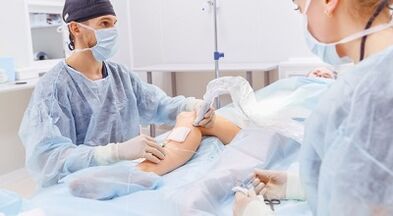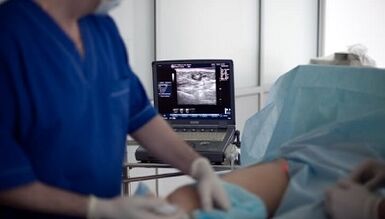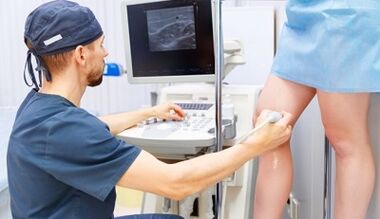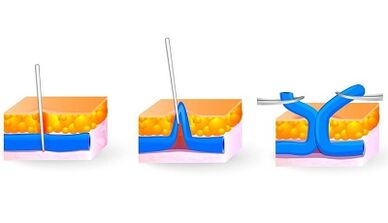
For decades, the surgical treatment of varicose veins of the leg is still the only thorough method to eliminate this disease and its complications.
Thanks to modern technologies and improving operating techniques, it is really effective both in terms of therapeutic and cosmetics, it is done easily and painless as possible, being tolerated well and does not cause prolonged disability.
Indications and contraindications
Patients should not be operated with any varicose veins.There are clear indications for operation and contraindications to perform it.
Treatment of surgery of varicose veins of the lower limbs is indicated in the following cases.
Medical indications- A noticeable expansion of 2-3 degrees of veins, accompanied by complaints and signs of chronic vein incidents:
- persuasion, tension veins under the skin;
- Many variables (nodes) along the vessels have changed;
- swelling of the legs is affected;
- The severity and pain along the expanded veins;
- convulsions in the calf muscles of the lower leg, when reducing the legs;
- changing inflammation in veins - thrombosis;
- Trophilical skin disorders, black, red spots, sealed under the skin, a long leaf wound.
Cosmetic indications- Early (first) stage of varicose veins without signs of intravenous failure, only causing cosmetic defects and cosmetic discomfort in patients:
- Located in a slightly expanded and complex appearance;
- "Star", "Spider" and small red capillaries on the skin of the legs.
It is important to remember that even when indicated from the operation, one must refuse if its risk exceeds the benefit.
The main contraindications for surgical treatment of varicose veins:
- The serious general condition caused by any acute disease (heart attack, stroke, pneumonia) has given chronic diseases (liver, intimate, lung failure) or old age of the patient.
- Any acute infectious disease.
- Treatment leads to cancer.
- Anemia pronunciation.
- A significant increase or a decrease in blood clotting.
- Inflammation and assumptions (scores, rashes) on the skin of the lower limb, where surgical intervention plans.
- Pregnancy and early postpartum period.
All the contraindications, except for the first time, is considered relative.This means that in special cases (acute dangerous conditions caused by varicose veins, for example, thigh thrombosis), one or another surgical treatment volume must be performed.
When needed an emergency activity
Emergency surgery treatment for leg veins can only be required in one case - with increased thrombosis.This complication is an inflammation inside the heart of a large skin vein, accompanied by the formation of blood clots.

If such a pathological process is applied to the thigh, there is a risk of clutching blood clots into a deep vein system.In the case of such a blood clot separation, he invaded the lungs and clog them, causing a threatening life of a dangerous disease - lung thrombosis (pulmonary fiber).
The main manifestations of the rising thigh thrombosis:
- Pain along the vein along the inner surface of the thigh;
- red and increase skin temperature;
- The seal of the area changes and its sharp pain when touching.
With increasing thrombosis, surgical treatment volume can be indicated:
- Surgical removal surgery - Wearing clothes and intersections of a large skin vein at a place where to stay with Bednaya;
- Remove a vein change after wearing preliminary clothes.
The goals of surgical intervention
Typically, about 30% of blood from the lower limbs flows through small veins under the skin, consolidated in the central veins - a large and small skin veins.These vessels are directly connected to deep veins, so that 70% of blood flows.In places of such compounds, there are blood transfusion valves from surface veins into deep veins.
There are also dozens of small veins, called Perforant, also connecting the surface venous network with deep.They also have blood transfusion valves in one direction.
The main cause of varicose veins is the failure of the veins, leading to improper blood discharge: from deep veins to the surface, increasing the pressure in them and leading to the expansion of both small and central veins.
The main goals that surgical treatment is aimed at varicose veins of the lower limbs:
- The removal of bloody stagnation in the changing surface veins of the leg, this will prevent the progression of chronic veins and booty dysfunction on the skin.
- Remove ships and deformed varieties representing a cosmetic defect.
- The removal of blood discharge from the veins deep into the surface veins - the tie and intersection of the perforated veins (family), as well as a large and small veins in places connected to deep people.
- Prevention of repetitive appearance of varicose veins.
Prepare for activities
Fully prepared for surgical treatment for varicose veins including:
- A pre -surgical test that allows you to evaluate blood and urine tests in general about health, coagulation, biochemical analysis, blood type and RH element, syphilis testing, blood sugar, pulmonary X -ray, ECG.
- Special diagnosis allows you to identify the characteristics of the disease - ultrasound with color doppler mapping of the surface, deep veins and arteries of the lower limbs and indicating the position of the perforated parasite.
- Activities are done when hungry, so in the morning on the day you cannot eat and drink.
- In the morning before surgery, it is necessary to carefully shave all hair on the legs from groin to feet.
Treatment of women's varicose veins

A separate position in the surgical treatment of varicose veins of the lower limbs belongs to cosmetic surgery.After such interventions, not only venous veins have been changed, but also after surgery scars on the skin of the leg, or they are unclear.
To achieve maximum cosmetic effects, surgical surgery for varicose veins is performed according to the following methods:
- The veins remove laser frequency or radio-Burn the central body of a large and small vein under the ultrasound control through a skin perforation on the thigh or on the feet.
- Root sclerosis and sclerosis-The output of large and small skin veins, as well as all their branches, even the smallest, with a special SCLEROCANT.
With any described treatment, venous veins are not removed, but turns from blood vessels into a soft fabric.Both physical effects (laser, radio frequency waves) and chemical compounds destroy the inner layer of the vein.Thanks to this, it loses its heart, glue and is completely canceled from the blood, turning into a regular connective tissue.
Therefore, if the veins are not removed directly, all the targets are assigned to the rapid treatment of varicose veins of the lower limbs are achieved - the changes are removed, and the dangerous consequences of veins are removed in them.
The only limitation of aesthetic activities in the treatment of varicose veins in women can only expand a bit or limit veins to 1-2 degrees.During pregnancy and in the early postpartum period, surgical treatment is contraindicated except for acute situations that need emergency intervention, for example, with increasing thrombosis.The activity is limited to wearing the clothes of a large skin vein at the connection with the femur (cross -section).
Types of surgical activities
Consider the most common surgical interventions in the treatment of varicose veins of the lower limbs: laser removal, intravenous surgery and removal surgery.
The second type is divided into the following categories:
- Classic, or completely deprived or activities of Trojanov-Trendelenburg-Bubko-Narata;
- Short deprivation;
- Miniflebectomy.
Fleebectomy
Remove and extract veins from under the skin is called Phlebectomy.This is one of the first surgical treatments for varicose veins of the lower limbs.But even today, Phlebectomy removal surgery is usually performed by Phlebo, the vascular surgeon.There are three modifications and operating methods: full, short deprivation, cutting miniflebectomy.
The volume of intervention is presented:
- Like a piece of the trunk under the large skin in its setting position, 2-3 cm in the lower thigh of the groin fold, in the thigh, through a incision.
- Removing it throughout the groin to the foot by using a special probe through two cuts of the skin 1-2 cm along the inner surface near the knee and ankle.
- The removal of all varicose veins and small veins through separate small incisions is about 1-2 cm (they can from 5-6 to 10 matches 20) with the wearing of perforated ships.
- Sewing all wounds with cosmetic lines.
The most classic phlebectomy allows you to remove varicose veins, but the most injury among all existing techniques.
Depred
With a short range, not the entire large veins under the skin are removed, but only its pieces, affected by varicose veins, for example, only in the thighs or lower legs.Healthy segments are not removed.This reduces the injury of intervention, but the risk of recurrence is still available.On the other hand, the activities of the activity are similar to the classic phlebectoma surgery.
Miniflebectomy

The creative method to remove the small veins of a large vein under the skin is called Miniflebectomy.
To do so, special tools (sharp scalpeles, hooks, clamps, spoons) are necessary, in which the veins are extracted through the skin of the skin of the skin a few millimeters.It is not necessary to sew such skin defects, scars are invisible.
Typically, surgeons combine a short or completely strip of a large subcutaneous vein with miniflebectomy removal surgery.Such combined combination of radicalism and minimum injury with good cosmetic effects.
Analysis of intravenous endoscopy
Looking for all inferior perforated veins in any phlebectomy removal surgery is difficult.For these purposes, laparoscopic devices (video camcorders and control machines) are used.Through the chopped cuts in 1-2 cm, they are inserted under the skin in places of venous clusters, detected by ultrasound.
Under the control of the camera, all less boreholes are found, ice and cross them.During this activity, the veins under the skin are not removed.It can be done independently and combined with any type of phlebectomy: deprivation, miniflebectomy.
Laser treatment
Laser removal for varicose veins associated with burning by a laser beam of a large vein under the skin from the side of its clearance.To do this, by piercing the skin on the thigh or the ankle area into the vein's heart, a catheter is put into its entire length.Under the control of ultrasound, SVetovod is extracted from.
Laser beams, action on the vein wall, destroy the inner layer.As a result, Vienna fell and stopped working, can be visible on the ultrasound screen.If not only the main vein trunk, but also its branches, removed by varicose veins, they are removed by the miniflebectomy method.
Rehabilitation
Regardless of which varicose veins treatment have been used, the recovery of patients during postoperative period occurs quickly.The terms of full rehabilitation depend on the surgical method, the stage of the disease and the general condition of the patient.With laser treatment and surgical surgery to remove the initial venous veins, it is 2-3 weeks, with classical molecular removal surgery for progressive diseases of the disease-3-month disease.
Walking is recommended as soon as possible, provided that this situation is stable after anesthesia - after 5-6 hours.If the spinal anesthesia is done, rest within 12 hours.With local anesthesia, patients may leave the operating room on their feet and not even hospitalized in the hospital.The main condition before walking is to bandage with elastic bandages or put a piece of compressed knit selected individually.
In the hospital from 1-2 to 5-8 days.If the roads are piled up, it is better to remove them in 7-8 days during control tests from an expert.Within a month after surgery, it is recommended to wear compressed knees.It is necessary to place it daily before leaving the bed.At night, compressed products are removed.After removing classic phleebectic with serious varicose veins, it is better to continue compressing for up to 3 months.
During the month, it was strictly prohibited:
- sauna and hot bath;
- Heavy physical activity in the lower limb;
- For a long time, in a standing or sitting position.
Complication
The most common complications related to operating for varicose veins:
- Pain in the foot is active due to damage to large nerves.
- The long swelling of the legs and lower legs.
- Hematomas and bruises on the lower legs and thighs.
- Bleeding from the wound.
- Flebotrombosis - Deep vein inflammation.
- Monitor after surgical wounds and necrosis (death) of the surrounding skin with the formation of trophic ulcers.
- The formation of blisters after surgery.
Thanks to modern methods and technologies, surgical treatment of varicose veins is easy, painless and highly effective.Compliance with all recommendations of the postoperative phase contribute to rapid recovery, minimize the risk of complications and recurrence.

























